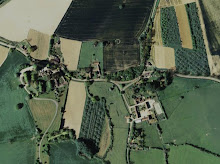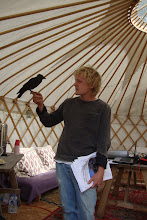.JPG)
My bee guru Tanya supervised another peek into my bee colony last week. This is the 'wild' colony that I managed to capture in my bait hive in the 1920s orchard. Since the colony is about to have a population explosion we added another story onto the hive (called a 'super') and hopefully it is from this that we will be able to harvest honey. And check out the suits...(could I bee any hotter?)!
.JPG)
.JPG)
Unfortunately to get into the hive we had to disturb this wild comb somewhat, but it provided the perfect opportunity to have a really nosey snoop around their magnificent wax world. You can see a cross-section through the brood comb and inside these cells are the white developing larvae. Along the top edge of the top photo the comb is for a different use - it has honey and pollen (the darker brown stuff) stored and this is both a food source for the workers and developing young. Do they have it on toast, you may well ask?
.JPG)
Look how delicately sculpted the cells are. This close up shows the sedimentation of pollen produced as different bees contribute their tiny parcels collected from a range of plants with different coloured pollen.
.JPG)
Whenever you open a hive and disturb the bees they tend to congregate and do this special nosier wing-fan action. This is their way of calling in any disorientated bees who have gotten lost or wandered off.
.JPG)
I know what you're thinking: who's this handsome lad? He's a male bee (or 'drone') and slightly larger than the female workers. A proportion of each colony is made out of drones (even though all of the workers are female) because no colony can reproduce without a fertilized queen. He was skulking on his own on one of the frames. Pull your wing out son and get pollinating!
.JPG)
We made some frames to go into the brood box and encourage the bees to build their comb on them. In this photo I am helping Tanya attach this wild comb onto a frame before returning it to the hive. Ideally we should have filled the box with frames very early on and then the bees would have had no choice but to build comb on them.
The advantage of the removable frame system is two-fold: Firstly, you can take them out to check up on their progress. Secondly, it is less energetically expensive for the bees to build comb on a frame with a sheet of wax that has the hexagonal cell pattern embossed into it (a 'foundation'). Wax takes about six times more energy than honey to make so this foundation reduces the amount of energy the bees spend on wax and thus they can produce more honey.
.JPG)
That metal grid thing is called a 'queen excluder'. It separates the brood box at the base with the 'super' above and has gaps that are just too narrow for the queens abdomen to fit through. This prevents her from laying eggs in the super, keeping it just for honey and pollen. Royal discrimination.
.JPG)
Picnicking with winnie the pooh? I got to take home some of the honey comb and it tasted goo-ood.







